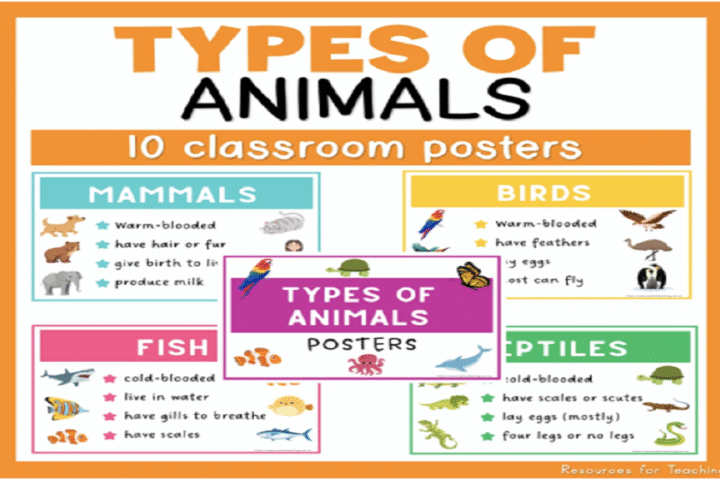In classrooms today, visual learning tools play a big role in helping students understand complex ideas. One of the most effective ways to teach early science concepts is through animal posters. These posters are more than just decorations,they are powerful teaching aids that create interactive learning opportunities for students of all ages.
Animal posters is one of the best teacher resources because they spark interest and open the door to hands-on activities, discussions, and games. When students learn about mammals, reptiles, amphibians, birds, and fish through visuals, the information becomes easier to remember. With the right strategies, animal posters become a foundation for a fun and effective learning experience.
Benefits of Using Animal Posters
Using animal posters as part of your lesson plan creates multiple benefits.
- They help with knowledge retention. Visuals connect images to facts, which strengthens memory and understanding. For example, a poster showing the difference between cold-blooded and warm-blooded animals allows students to see and compare the traits easily.
- They support diverse learning styles. Visual learners benefit from the images, while kinaesthetic learners benefit when posters are included in movement-based activities like matching games or sorting exercises. Audio learners can get involved when the posters are used during class discussions and storytelling sessions.
- Animal posters help create a print-rich environment. When students constantly see words like “mammal” or “invertebrate” alongside pictures, they begin to associate words with meanings. This supports both science learning and literacy development, especially in early grades.
Making Lessons Interactive
To make the most of animal posters, teachers can design activities that invite student participation. One simple way is to use a sorting game. Print small animal pictures and let students match them to the correct group on the poster. For instance, they can place a dolphin picture under “mammals” and a turtle under “reptiles.” This allows them to apply knowledge through action.
Another activity involves “Guess the Animal.” Here, one student picks an animal (based on the posters), and others ask yes-or-no questions to figure it out. This builds critical thinking skills and encourages students to use classification terms in a fun, meaningful way.
Animal posters can also serve as prompts for research projects. Assign each student an animal group and let them explore key facts—habitat, diet, features—then present their findings to the class. This introduces basic research skills and builds confidence in speaking.
For younger students, posters can inspire storytelling sessions. The teacher picks an animal from the poster, and the class helps build a story around it. This taps into creativity while reinforcing animal traits and categories.
Displaying Posters for Maximum Impact
Placement of animal posters matters. Teachers should hang them where students can see them during lessons and independent activities. Posters near reading corners, science centres, or whiteboards allow for frequent use and reference.
Rotate posters every few weeks to introduce new animals or classification themes. For example, one month can focus on vertebrates and the next on invertebrates. This keeps content fresh and students engaged.
Teachers can also encourage students to interact directly with the posters by letting them add sticky notes with fun facts or draw their own animals to place beside each group. This kind of classroom ownership fosters a sense of involvement and builds stronger connections with the content.
Connecting with Curriculum Goals
Animal posters can support learning outcomes across subjects. In science, they connect with units on ecosystems, adaptations, and biodiversity. In language arts, they support vocabulary, reading comprehension, and writing prompts. In art, they inspire drawing or clay modelling activities. These cross-curricular links make posters a flexible and valuable classroom tool.
Many schools in Australia follow specific curriculum frameworks. Posters that match these learning goals help teachers stay on track while adding creativity to their lessons. Websites offering teacher resources Australia educators trust often provide posters that align with curriculum outcomes, saving teachers time and effort.
Where to Find the Best Animal Posters
Several teacher resources websites offer printable animal posters. Choosing high-quality visuals and accurate content is key. Look for posters that clearly label each group and include facts in simple language. This supports both understanding and engagement.
One great example is the collection of resources for teaching available online. Their teaching resources include animal posters that work well for visual learning. These posters are designed to be clear, colourful, and aligned with curriculum goals. Teachers across Australia have used them to boost engagement and make science lessons more enjoyable.
Final Thoughts
Animal posters do more than decorate classroom walls. They turn static lessons into interactive experiences. With thoughtful planning, teachers can use them to boost memory, encourage participation, and make learning enjoyable. From group games to individual projects, the possibilities are wide. Visit Resources For Teaching, one of the best teacher resources websites you will ever find.




